Kingfisher had been neglected for several months, displaced from her protected shelter under my house by a mitering workstation, and ignored by the arbitrary demands of home improvement. Plans for a sail were disrupted by a flat and dislodged tire, rusty and frozen lug nuts, and a wheel spinning on the ground. With the help of penetrating oil, an overnight interlude, persistence, and an old jack handed down from my father, the old wheel came off, and we were ready to roll. I took the time to wash the tree debris off Kingfisher, and found a tree frog on deck. The amphibian was still riding on the deck after I arrived at the landing. The thought of having this companionship for the voyage was intriguing, yet I removed the web-footed crew to the relative safety of the mainland, expecting a lively and wet sail across Bulls Bay.
The desire to launch was inspired by most favorable conditions for the voyage. The outgoing tide and north wind were already at play as I went through the satisfying process of rigging, completing all the minutiae – a square knot here, the click of brumel hooks there. I was greeted by my neighbor Jan Snook, and we talked about the passing of Tropical Storm Irma. As I prepared to raise sail I asked if she would do the honors of casting off Kingfisher’s bow line, and thanked her as I got underway. Reaching off with the north wind the craft’s stability allowed me to lean back and look aloft at a brown pelican soaring closely overhead.
Besides one awkward rounding into the wind to set the vang we passed smoothly through the creek and out into the Bay. The crossing was wet and quick, and as we approached the Northeast Point a number of people appeared on the island’s northern tip. It was a Beach Drop morning for Coastal Expeditions, and the ferry Caretta was heading south in Bull Creek after disembarking her passengers: later I was told that due to the demand two other boats participated in the ferrying. Pulling out Kingfisher’s daggerboard I caught a small wave and surfed close to the strand before rounding up and jumping out to complete the landing – a fine passage from dock to beach in forty minutes.
My anticipation of having the island to myself was dashed. One of the beachgoers approached, and this man wore a shirt I also own – Waccamaw National Wildlife Refuge with swallow-tailed kite – and he offered to help move my boat. I willingly accepted, and we dragged Kingfisher up the beach for a safe distance with my planned walk’s duration in mind. Jimmy Watson and his wife Barbara, both SC master naturalists were on the island with their daughter, son-in-law, and granddaughter Marilyn.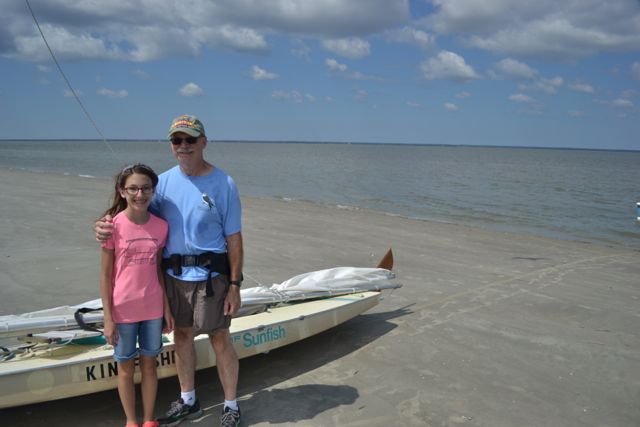
Marilyn and Jimmy
I mentioned his shirt in our conversation, and he shared about going to Allendale in July to see these magnificent and usually solitary birds feeding in fields in groups up to 80.
My walk to the Boneyard and back was guided by the desire to see what the effects were on the island from Tropical Storm Irma. I saw the damage it created along the ICW in Awendaw, and had ventured out on foot during Irma’s passing to see the pounding of the docks at high tide. Up above the normal high tide line around the curve to the island’s eastern face, there was no trace of the area cordoned off for nesting birds, and only a couple of stakes marking the planted grid for the endangered beach plant Seabeach amaranth remained.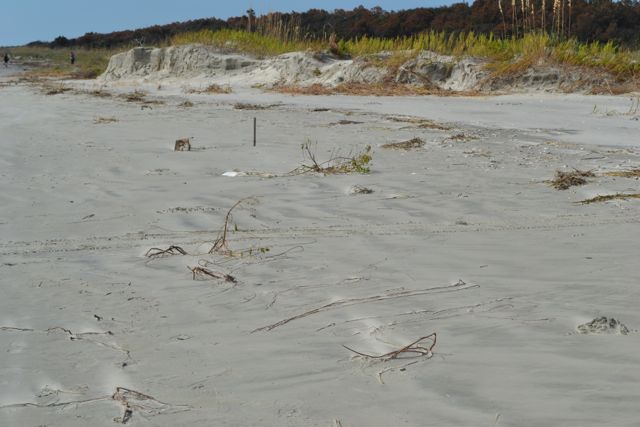 I learned later that of the two thousand plantings only six remained. Four hundred loggerhead nests throughout CRNWR had not hatched prior to the storm, and it was estimated that three-quarters of those nests were destroyed.
I learned later that of the two thousand plantings only six remained. Four hundred loggerhead nests throughout CRNWR had not hatched prior to the storm, and it was estimated that three-quarters of those nests were destroyed.
Passengers from the Beach Drop were spread out along the strand, most in pursuit of shells. 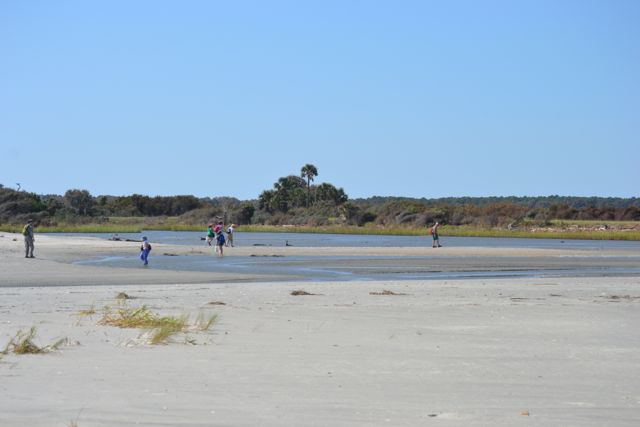 My pace was geared for a walk deep into the Boneyard, and I chatted briefly with folks in passing. SIgns of Irma’s impact were everywhere. Skimmer Key to the north of the Northeast Point appeared to be scoured clean, with no evidence of colonizing plants remaining. The dike along Jacks Creek was eroded out in numerous places, and the dike by New Pond was opened up to expose the internal structure.
My pace was geared for a walk deep into the Boneyard, and I chatted briefly with folks in passing. SIgns of Irma’s impact were everywhere. Skimmer Key to the north of the Northeast Point appeared to be scoured clean, with no evidence of colonizing plants remaining. The dike along Jacks Creek was eroded out in numerous places, and the dike by New Pond was opened up to expose the internal structure.
There were several new creeks cutting across the beach, and the one marking the endpoint of my walk to the south was the outflow from Moccasin Pond, the chocolate-colored waters surging out to the ocean. This opening in the Boneyard continued to be one of the most dynamic on the island, and fresh piles of palmetto logs bore the mark of Irma.
It was gratifying to see one of the familiar oaks standing out in the surf still erect.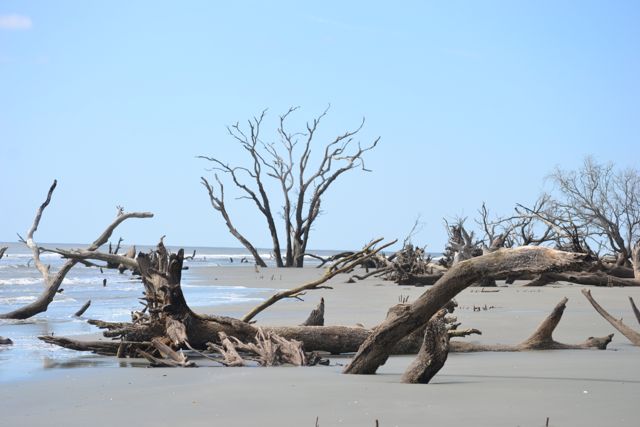 I was also pleased to see an osprey carrying its catch, indicating that all was well with nature despite Irma: the island overall continued to display a remarkable resilience.
I was also pleased to see an osprey carrying its catch, indicating that all was well with nature despite Irma: the island overall continued to display a remarkable resilience. 
On the return walk I noted a grouping of whelks culled by one of the shellers. Shelling was not on my agenda, yet my gaze often turned to objects littering the shore, whether manmade or natural. A black object caught my attention, appearing like a round marine plastic fitting, and an initial nudge with my foot did not dislodge it. Pulling it out of the sand, I found it to be a very thick piece of glass, clearly the bottom of a bottle, with an upside down profile containing a deep bowl-like indentation. The glass was purple but the indentation contained an array of hues; this beautiful bottle fragment was worth sharing with others. I had earlier seen on the beach the mate and naturalist from Caretta, Nick Johnson. During our conversation a black object had caught his eye, and he had picked up a sizable prehistoric potsherd, an antiquity to pass on to the Sewee Center. Catching up with Nick and his father on the return, I gave the glass object to him. His interest was piqued, and he planned to add it to the collection of objects on Caretta.
I walked on with Nick around the point with the other island visitors returning for their 2PM pickup. I did a double-take at the wind direction, a moderate easterly breeze that would allow me to run downwind across the Bay. I recounted to Nick my first meeting with his boss Chris Crolley in April of 2004. As I had prepared to sail back from the island, Chris had noted seeing Kingfisher sailing over on the fine NW breeze in the morning, and the shift to a SW direction had set me up for an easy return. He had wondered about my karma in having the winds so accommodating for the passages. He also had offered assistance including towing if ever needed (I have not had to utilize this help – yet). I mentioned to Nick having the karma again: it was not always the case, but when present I would take it. I did accept Nick’s offer of helping drag Kingfisher back to the water.
After a brief reach over to take a look at the flattened Skimmer Key, I began the crossing of the Bay. A line of boats were positioned near the channel, engaging in the early days of this year’s shrimp baiting season. With the moderate east wind, we ran freely down the Bay until entering the creek. Winding through the sections of Anderson Creek, my karma tank registered empty – the wind died. Fortunately the incoming tide pushed us on. Prior to the ICW a little wind came up, requiring a tack or two. It was a minor blip in the final passage to the dock.
The durability of nature observed on the island was also evident elsewhere, and the beauty of the marsh grass shimmered despite the pounding a week before. The cordgrass was beginning to bloom, and the approaching fall days would soon turn the bountiful swaths golden. I was reminded of my first walk to the marsh after Hurricane Hugo. The maritime forest was devastated, all brown and defoliated, yet the marsh had a surreal quality, appearing vibrant and untouched in the midst of the destruction. Nature endured then and on this post Irma day.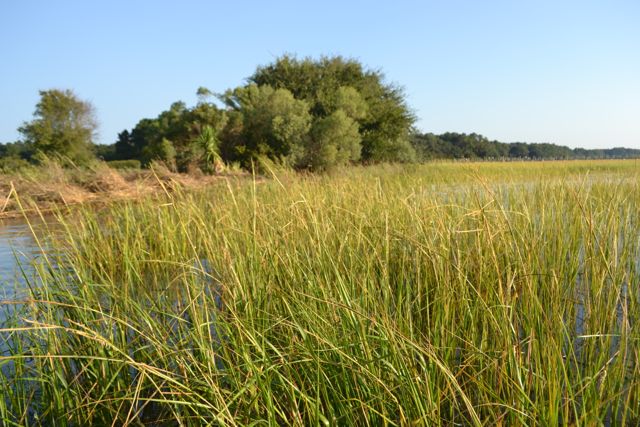








Excellent trip report as always Bob. It’s almost like the reader is there with you. I’m planning an early November visit. Can’t wait.
Glad you were along for the trip. November is a great time, though I have yet to find any bad ones.
Thanks, Bob, for taking the time to share your thoughts and pictures. It’s like having a special friend stop by to chat, leaving ideas to enjoy and ponder today and in the days ahead as we become immersed in the wonder of our natural world. Genuinely appreciated! Scott
Thank you Scott. Continue that immersion.